Earlier this week Becky and I made our 10th annual pilgrimage to the Tucson Gem and Mineral Showcase to purchase materials for her jewelry making. The Tucson Gem Show is always held over a two-week period at the end of January and the first part of February. And, even after 10 years, we both still find the event simply mind boggling!
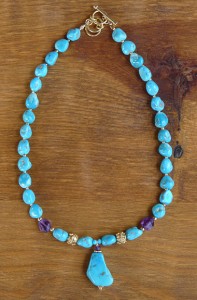
The history of the Tucson show begins in 1955, when a small group of rockhounds and mineral collectors from the the Tucson Gem and Mineral Society held a public exhibition in a local elementary school. Today, the show is recognized as one of the largest and most popular gem, mineral and fossil events in the world, consisting of some 45 separate shows held at various locations in Tucson, Arizona, attracting over 55,000 people and thousands of vendors and buyers from all over the world, during the two-week period. Even though we’ve gone every year for ten years, we have still only been to two of the larger wholesale shows, patronizing the same vendors each time, with whom Becky has established a good business relationship and level of trust regarding the quality and source of the materials she purchases.
Becky uses gems and semi-precious stones from all over the world in crafting her jewelry. However, from the beginning, her main focus has been on turquoise, especially domestic turquoise mined here in the American Southwest.
Turquoise is classified as a hydrated phosphate of copper and aluminum having the chemical formula of CuAl6(PO4)4(OH)8.4H2O. It is formed when groundwater percolates through rocks containing an abundance of copper, aluminum and phosphate and then is redeposited as a secondary mineral. Consequently, it is associated with copper deposits most commonly in arid or desert areas.
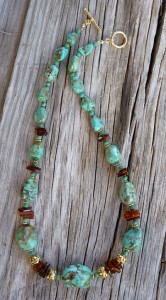
Turquoise has been treasured as a valuable and sacred gemstone by many world cultures for thousands of years. Ancient Egypt, Persia, Tibet and China valued the stone most highly. In the American Southwest, turquoise was mined by the prehistoric Native American cultures at least a thousand years ago from mines located in New Mexico and Arizona, and archaeological discoveries in Mexico and Guatemala suggest that this turquoise was traded as far south as Central America. Most of the literature about the mining of turquoise in New Mexico by prehistoric Native American cultures references the Cerrillo Mines in North-Central Mexico with a connection to the Chaco Canyon Anasazi culture. However, in Southern New Mexico, it is also known that in the Burro Mountains (just 15 miles southeast of the Casitas) and in the Hachita Mountains (115 miles south of the Casitas) turquoise was mined by the prehistoric Native American Mogollon or Hohokum cultures hundreds of years before both of these areas became important turquoise producers in the 1880s and early 1900s.
Some of the best turquoise ever mined in New Mexico came from the Burro Mountain deposits.
In 1891, The Azure Turquoise Company organized in New York and began developing the Azure Mine in the Burro Mountains. The Azure Mine produced a very hard, robin’s-egg-blue turquoise that was claimed to be comparable to the finest Persian turquoise, the standard for gem quality at the time, and was guaranteed not to change color or fade. By 1907, the Azure Mine was reported to have produced several million dollars of gem turquoise, a very substantial sum in those days! The Burro Mountain turquoise mines ceased activity around 1910. In the early 1900s, Phelps Dodge Mining Company began acquiring all of the property on which the Burro Mountain turquoise deposits were located. In 1967 they began a large-scale, open-pit copper mining operation at Tyrone. In 2007, the Phelps Dodge holdings were purchased by Freeport-McMoRan Mining Company.
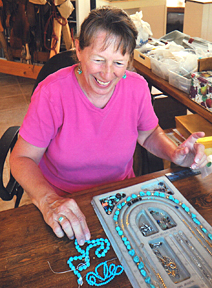
Largely because of the economic success of the Azure Mine and the Tiffany Mine in the Cerrillos District, by 1909 New Mexico turquoise had moved from having trinket value to gem status. After 1910, supply and demand plus the vagaries of fashion guided turquoise production in the Southwest through several boom and bust cycles, with numerous small mining operations opening and closing throughout Arizona, New Mexico and Nevada. Today, largely due to depleted deposits, steadily increasing economic and environmental constraints, plus competition from major turquoise mining operations in China, there are only a few turquoise-producing mines left in the American Southwest.
Over the 10 years that we have been attending the Tucson Gem Show, we have watched the availability and variety of quality Southwest turquoise decrease significantly while the price has increased geometrically. At the same time, less expensive Chinese turquoise has flooded the marketplace. While Chinese turquoise can be of high quality, often it is not, nor is it what it is represented to be. Since a significant portion of the turquoise market is devoted to the fashion trade, where color and stone shape are the main considerations, many second and third tier sellers have no idea as to the source or type of processing of the turquoise they are selling. Nor do they care to know.
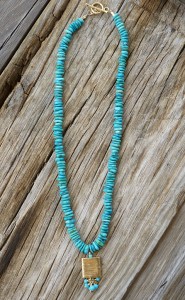
Another factor, which complicates the issue even more for the novice turquoise buyer, is the fact that only about 5% or less of the turquoise on the market today is a completely natural stone, hard enough to be made into jewelry without further processing. The other 95% must be stabilized with various types of acrylic or epoxy to give the stone durability plus the ability to take a high polish and not change color or absorb oils from the wearer’s skin. While stabilized turquoise may be frowned on by the purest, it is an acceptable industry practice … as long as it is disclosed by the seller that the stone has been treated in this manner. And, of course, it makes the stone more affordable.
Most turquoise vendors will acknowledge that their stones are stabilized. But other things may be done that are not disclosed by the vendors. Many poorer grade turquoise deposits yield considerable amounts of very pale, chalky material, so in addition to the stabilization process, artificial color is added to make the stone more attractive. An even lesser grade turquoise stone is produced by taking dust, small chips or pieces of otherwise unusable material, adding a color dye and then “reconstituting” it with epoxy and compression … sort of like making a turquoise tater-tot. Stones may even be rubbed with black shoe polish, because having a black matrix is deemed to be more desirable! Then there is the bargain basement of the turquoise marketplace, where you will encounter “turquoise” which is actually a soft, white, chalky mineral such as magnesite or howlite that has been dyed to a bright turquoise color. And then there’s that blue-green 100% pure plastic imposter.
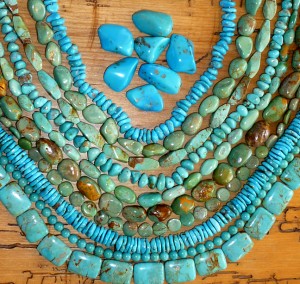
Under such market conditions, it is imperative that the seeker of good quality and genuine Southwest turquoise know from whom they are purchasing. It is for these reasons that Becky only buys her turquoise material from the same reputable miners and dealers who know and will guarantee their product. At present Becky is using both natural and stabilized turquoise in her jewelry from the following Southwest mines:
Sleeping Beauty: An actively-producing mine located in Globe, Arizona, yielding both natural and stabilized product which has a uniform robin’s-egg-blue color with little or no matrix. Considered by many to be the standard by which other mines are judged, and the only U.S. mine to produce exactly this unique color turquoise.
Kingman: Another actively-producing mine located near Kingman, Arizona, yielding both high quality natural and stabilized product in several varieties and grades ranging from deep blue to blue-green, with or without matrix minerals such as pyrite. Considered a classic turquoise stone.
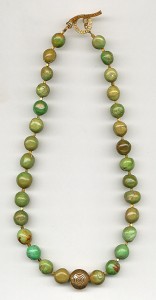
Royston: An active, though small-scale, mine with limited production located in southwestern Nevada, yielding deep green to light blue colors, often together with a dark brown to gold colored matrix.
Emerald Valley: This active, though small-scale mine is located in southwestern Nevada near the Royston deposits and is a dark green to greenish blue with a complicated matrix.
Castle Dome: This mine, located near Globe, Arizona closed in the early 1970s. Current stones are available in limited quantities from old stockpiles. This stone is characterize by its bright blue color with a light brown to gold matrix.
Fox: This mine, located in Lander County near Crescent Valley, Nevada, is now reportedly closed but stone is still available from old stockpiles. Color is green to blue green with a distinctive matrix.
Morenci: This mine located in Morenci, Arizona, is now closed, however material is still available from old stockpiles. The color ranges from light to dark blue and is characterized by an irregular matrix of pyrite which polishes to a silvery luster.
Nacozari: This mine is located south of Bisbee, Arizona, in Sonora, Mexico. It has a pale blue color with very little matrix material.
Campo Frio: This mine is located in the Cananea area of northern Sonora, Mexico. It is an olive green to sky blue color with a light brown to gold matrix.
You can see more of Becky’s handcrafted southwest turquoise jewelry on the Casita’s Gallery website.


